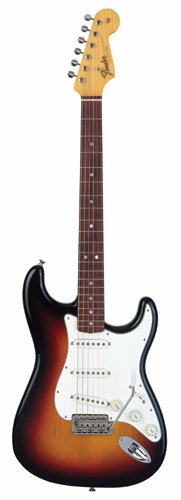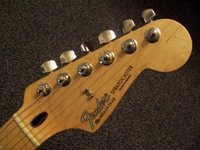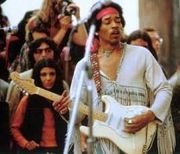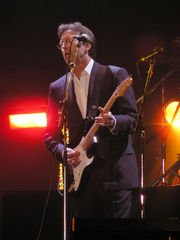| Fender Stratocaster |

|
| Manufacturer |
Fender |
| Period |
1954 - present |
| Construction |
| Body type |
Solid |
| Neck joint |
Bolt-on |
| Woods |
| Body |
Alder or Ash |
| Neck |
Maple |
| Fretboard |
Maple, Rosewood |
| Hardware |
| Bridge |
Synchronized Tremolo |
| Pickup(s) |
3 Single-coil |
| Colors available |
|
(Standard Series, as of 2005) Black, Sunburst, Sage Green Metallic, Blue Agave, Midnight Wine, Arctic White (other colors may be available)
|
The Stratocaster, often called the 'Strat', is a model of electric guitar designed by Leo Fender in the early 1950s,
and manufactured continuously to the present. The Stratocaster has been used by many leading guitarists and on many historic
recordings: Along with the Gibson Les Paul and the Strat's older cousin, the Fender Telecaster, it is one of the most enduring
and common models of electric guitar in the world.
The Stratocaster has been widely copied, such that 'Stratocaster' or 'Strat' can also denote a type of guitar, by various manufacturers,
showing the same general features as the original. However, in many jurisdictions the word 'Stratocaster' is reserved for Fender guitars.
Origins
The Fender Electric Instrument Manufacturing Company (now known as Fender Musical Instruments Corporation) developed the first
commercial solid-body 'Spanish' (as opposed to 'Hawaiian,' or lap steel) electric guitar in the Telecaster, a simple design whose
earliest models were offered under various names like Broadcaster or simply Esquire, beginning in 1950. Though the Telecaster and
its variants were successful, many guitar players of the day insisted on using a Bigsby unit, a fairly primitive spring-loaded
vibrato device with which players could bend notes up and down with their pick hand. Instead of adding a Bigsby, Fender decided
to produce a new, more expensively-made ash or alder line of guitars with his own design of vibrato. His decision was also
influenced by guitarists Rex Gallion and Bill Carson, who requested a contoured body to temper the harsh edges of the slab-built
Telecaster; the new ash body design was based on that of the 1951 Precision Bass.

The headstock shape of the Stratocaster is actually copyrighted.
The name, 'Stratocaster,' was intended to evoke images of newly emergent jet-aircraft technology (such as the Boeing B-52 Stratofortress),
and to express Fender's modernistic design philosophy. In designing the Stratocaster's body, a significant area of the back of the guitar,
and the area where the strumming arm rests, were beveled to accommodate the player's chest and arm. The upper bouts featured two cutaways,
for easier access to the higher frets. The new 'Custom Contour Body' and 'Synchronized Tremolo' bridge made the Stratocaster a revolutionary
design. The guitar also featured more complex electronics than the Telecaster: three single coil pickups, each with staggered magnetic poles;
a three-way selector switch; one volume knob, and two tone controls. (A three single-coil pickup design was an innovation already in use by
Gibson in their ES-5 model since 1949. However, Fender's pickups were much more compact.)
Patents were applied for all these new designs, and production line Stratocasters reached the market in early 1954 for $249.50. The basic
production model had a two-tone nitrocellulose 'sunburst' finish, an all-maple neck, ash body (1956-later alder), chrome hardware, and
Bakelite-like thermoplastic parts. Other manufacturers began imitating these innovations immediately.
An early-model Stratocaster, along with his black-rimmed glasses, was a key component of Buddy Holly's signature look, and he was among
the first players to popularize the Stratocaster in rock music. Both his gravestone and his walk-of-fame statue in Lubbock, Texas feature
his Stratocaster.
Sound and playability

Jimi Hendrix at Woodstock with a 1968 Stratocaster, a right-handed model played left-handed, with the strings in the standard order relative to the guitarist.
Much of the popularity of the Stratocaster can be attributed to its versatility. The neck, middle, and bridge (in the original manual,
labelled "rhythm", "normal tone", and "lead", respectively) pickups provide a wide range of tones. The standard single-coil pickups often
found in Stratocasters produce a trebly sound with a high top end and bell-like harmonics. The Stratocaster has been used for a variety
of purposes, from the classic "Fender twang" to the slicing solos of Jimi Hendrix and Eric Clapton to the fat, crunching tones in Ritchie
Blackmore's Smoke on the Water".
The Fender synchronized tremolo tremolo arm mechanism, introduced with the Stratocaster, has become the most copied design of all,
eclipsing all other designs including the later floating bridge designs by Leo Fender himself.
The Telecaster also remained in production, and both the Stratocaster and the Telecaster flourished into diverse families of guitars, with
many variants. Each continues to enjoy its own following among guitarists.
Design and popularity changes
In 1959-1967, the Stratocaster was refitted with a rosewood fretboard, as well as color choices other than sunburst, including a variety
of colorful car-like paint jobs that appealed to the nascent surfer and hot-rod culture, pioneered by such bands as the Ventures and the
Beach Boys. Dick Dale, the godfather of surf-rock, was a prominent Stratocaster player who also collaborated with Leo Fender in developing
the Fender Showman amplifier. In the early 60's, the instrument was also championed by Hank Marvin - guitarist of the Shadows, a band
which originally backed Cliff Richard and then produced instrumentals of its own. So distinctive was the Hank Marvin sound that many
musicians - including the Beatles - initially deliberately avoided the Stratocaster and chose other marques. However, by 1965, George
Harrison and John Lennon of the Beatles both acquired Stratocasters at about the time of the Rubber Soul recording sessions. It was
Jimi Hendrix who widely popularized its use once again in the late 1960s.

Eric Clapton plays his signature model at the Tsunami Relief concert, January 22nd 2005
The one-piece maple neck was discontinued in 1959. However, a maple neck with a glued-on maple fretboard was offered as an option in 1967.
The rosewood fretboard over maple neck remained as the other neck option. In 1969, after a ten year absence, the one-piece maple neck was
made available as an option.
Many artists (including Eric Clapton, Jimi Hendrix, and Mark Knopfler) discovered that the pickup selector could be lodged in between the
basic three settings for further tonal variety. Since 1977, Stratocasters have been fitted with a five-way switch to make such switching
more stable. Other, often subtle changes were made to the guitars over the years, but the basic shape and features of the Strat have remained
unchanged. In the 1980's some popular guitarists began modifying their Stratocasters with a humbucker pickup in the bridge position. This was
intended to provide a thicker tone preferred in heavier styles of music. The popularity of this modification grew and ultimately Fender began
releasing factory built models with a bridge humbucker option.
Players first perceived a loss of the initial high quality of Fender guitars after the company was taken over by CBS in 1965. So-called
'pre-CBS' Stratocasters are, accordingly, extremely sought-after and expensive. In recent times, some 1954 to 1958 Stratocasters have sold
for more than $75,000. Many now reside in Japan, cached away as collectable pieces of Americana.
The Stratocaster fell out of fashion in the mid-sixties, to the point where the Fender company (owned by CBS) reduced its price and considered
removing it from their production line completely. However, Jimi Hendrix and many other blues-influenced artists of the late '60s soon adopted
the Stratocaster as their main instrument, reviving the guitar's popularity. Both George Harrison and Eric Clapton used Stratocasters in the
1971 Concert For Bangladesh, giving the Strat additional high visibilty in rock circles.
After a peak in the 1970s, driven by players such as David Gilmour of Pink Floyd, Eric Clapton, and Mark Knopfler of Dire Straits, another lull
occurred in the early '80s. During that time, CBS-Fender cut costs by deleting features from the standard Stratocaster line, despite a blues
revival that featured Strat players such as Stevie Ray Vaughan, Robert Cray, and Buddy Guy (a Strat player since the mid-1960s, sometimes
credited with influencing Jimi Hendrix, Eric Clapton, and Stevie Ray Vaughan in their choice of the Stratocaster as a primary blues-rock guitar).
However, this lull abated once the company became independent of CBS, and a rise in mainstream popularity for vintage (and vintage-style)
instruments resulted.
Current models
Fender now offers an extensive line of vintage Stratocaster reissues and more modern variants (with the same basic shape and features) -built
in California, Mexico, Japan, and Korea-as well as maintaining a Custom Shop that builds guitars to order. Those who wish period-accurate
replicas can obtain Strats and other Fender instruments with original-style cloth-coated wiring, pickup and electronics designs, wood routing
patterns, and even artificial aging and oxidizing of components using the Custom Shop "relic" process. There is also a budget-minded "Squier"
line from Fender, which is popular among novice guitarists. These are typically made in Indonesia or China and use woods more common to those
countries, one example being Agathis.
Replica models / famous Strat players
Fender has also offered both Custom Shop and regular production Artist Series guitars, featuring replicas of the Stratocasters played by
famous guitarists such as: Jeff Beck, Eric Clapton, Robert Cray, Dick Dale, Rory Gallagher, Buddy Guy, Eric Johnson, Mark Knopfler, Yngwie
J. Malmsteen, John Mayer, Robin Trower, Stevie Ray Vaughan, Jimmie Vaughan and others.
Other notable Strat players include: Jeff "Skunk" Baxter, Jason Becker, Tommy Bolin, Bob Dylan, The Edge, John Frusciante, Janick Gers,
Mick Green, Albert Hammond Jr., George Harrison, Mary Kaye, Terry Kath, Ed King, Mike McCready, Dave Murray, Mike Oldfield, Bonnie Raitt,
Uli Jon Roth, Steve Rothery, Mike Rutherford, Richie Sambora, Pat Smear, Adrian Smith, Richard Thompson, Dean Ween and Frank Zappa.
Trivia
- The white Stratocaster with serial number 0001, once belonging to Homer Haynes and sporting an anodized gold pickguard and gold
hardware, is owned by Pink Floyd guitarist David Gilmour. This guitar, however, was not the first Stratocaster made. It is
believed to be a very early "custom color" Strat.
- As of 2000, there were "thirty-one distinct factory-made Stratocaster models available"
- Leo Fender, the guitar's designer, could not play guitar.
- Paul Reed Smith, president of PRS Guitars, has said that "Leo Fender was in a 'state of grace' when he designed the Stratocaster."
- In 2006, a Stratocaster which was autographed by Bryan Adams, Eric Clapton, Jimmy Page, Mick Jagger, Keith Richards, Ronnie Wood,
Brian May, Liam and Noel Gallagher, Jeff Beck, Pete Townshend, Ray Davies, David Gilmour, Tony Iommi, Mark Knopfler, Angus and
Malcolm Young, Paul McCartney and Sting was sold at a fundraising auction in Qatar for US$2.6 million to Her Highness Sheihka
Miyyassah Al Thani, shattering the previous record held by Eric Clapton's "Blackie" which fetched US$959,500 at a charity auction
in 2004.
- Dweezil Zappa tried to sell a sunburst Strat that Jimi Hendrix had played (and burnt) onstage; the guitar was then modified and
used by Frank Zappa in the 1970s. His asking price of $1,000,000 received no takers.
- In 1993, Jimi Hendrix's 1968 "Woodstock Strat" (as seen in the above image) with serial number 240981 was sold for 1,275,000 Euros
to the Italian art collector called Red Ronnie. It is now in Microsoft billionare, Paul Allen's possession and is the main
attraction for his Experience Music Project in Seattle, Washington.
References
- Bacon, Tony. 50 Years of Fender: Half a Century of the Greatest Electric Guitars. Backbeat Books, 2000.
This article is licensed under the GNU Free Document License
It uses material from the Wikipedia article - Fender Stratocaster
|
